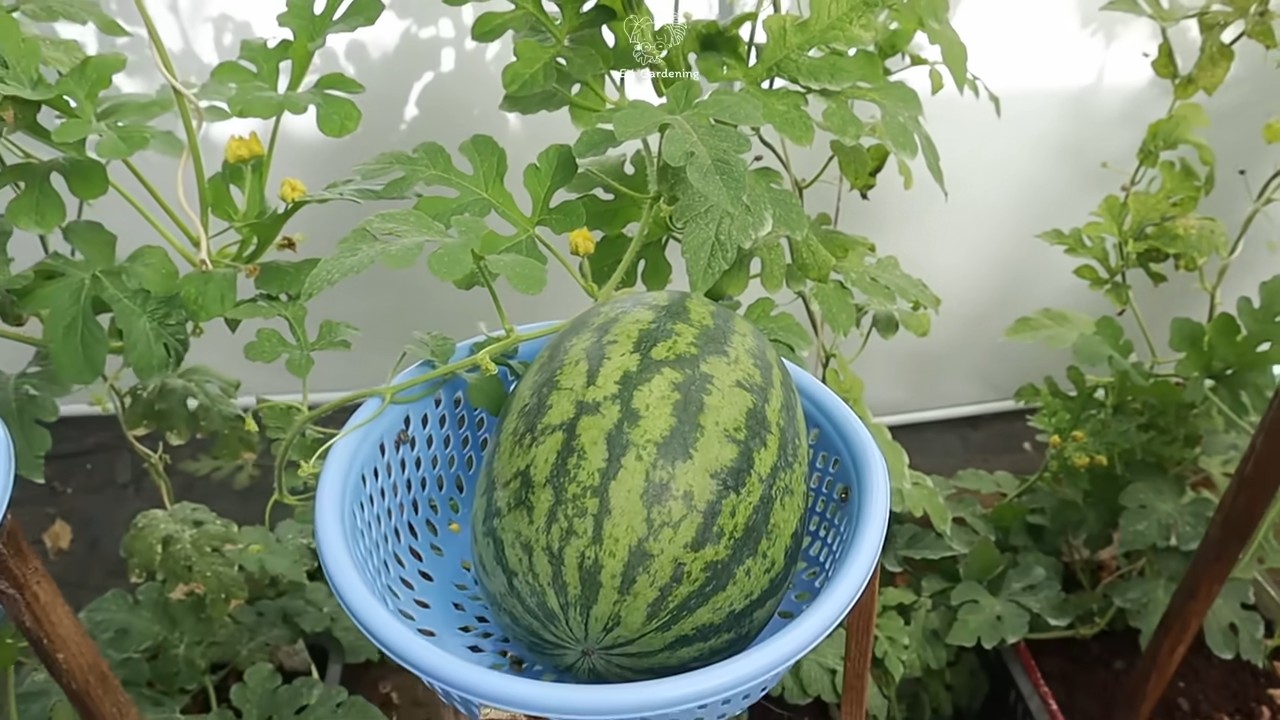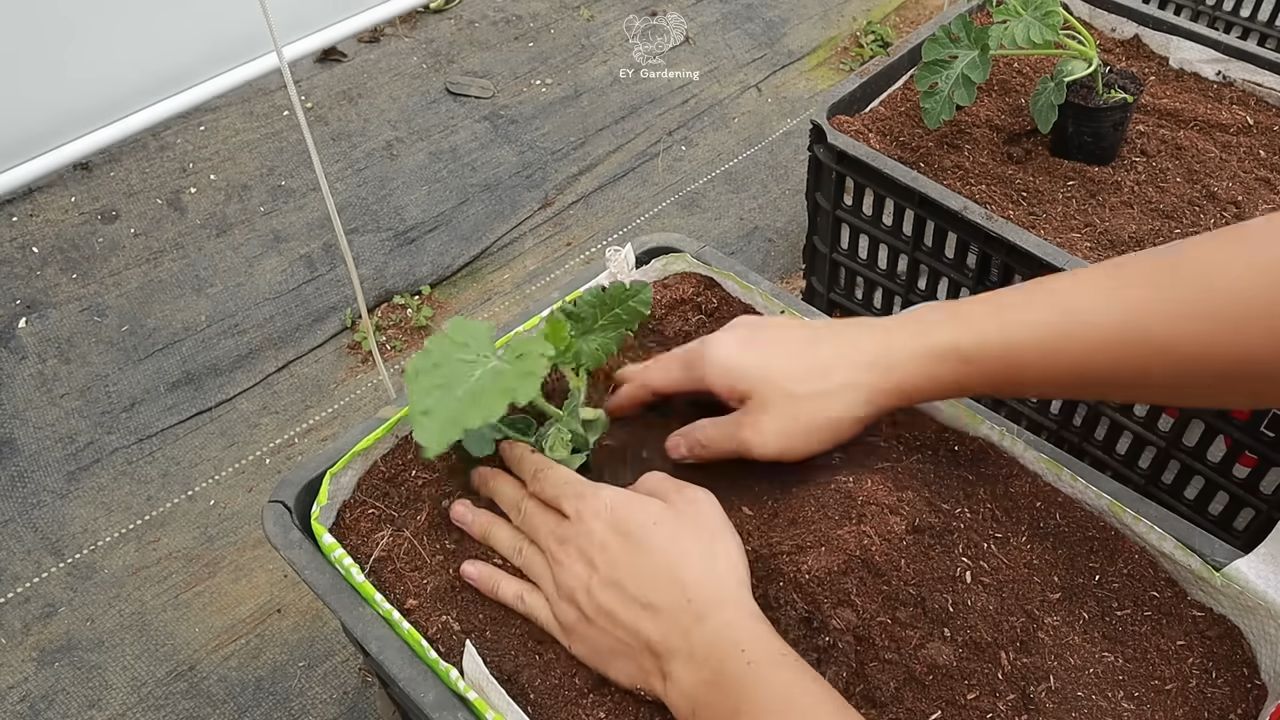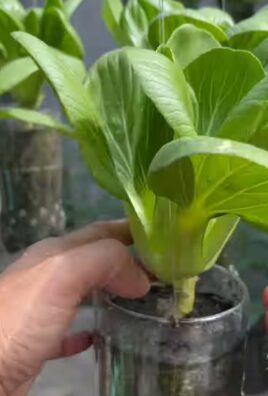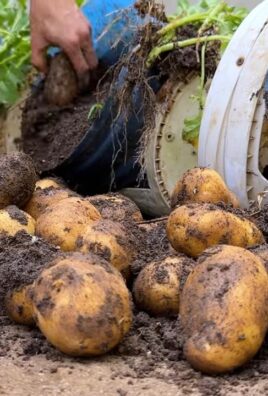Grow Watermelons in Small Spaces? Absolutely! Imagine sinking your teeth into a juicy, homegrown watermelon, bursting with flavor, even if you only have a tiny balcony or patio. It sounds like a dream, right? Well, it’s a dream within reach! For centuries, gardeners have been finding clever ways to cultivate delicious produce, adapting techniques to suit their environments. From ancient rooftop gardens in Babylon to modern-day urban farms, the spirit of resourcefulness has always driven innovation in horticulture.
But let’s be honest, most of us don’t have sprawling acres to dedicate to sprawling vines. That’s where these DIY tricks and hacks come in. Maybe you’ve always thought growing watermelons was only for those with large gardens, but I’m here to tell you that’s simply not true! This article is packed with practical, easy-to-follow tips that will empower you to grow watermelons in small spaces successfully. We’ll cover everything from choosing the right varieties to vertical gardening techniques and even clever watering strategies.
Why do you need these DIY tricks? Because fresh, homegrown watermelon tastes infinitely better than anything you can buy at the store! Plus, there’s something incredibly satisfying about nurturing a plant from seed to fruit. So, get ready to unleash your inner gardener and transform your limited space into a watermelon wonderland!

Growing Watermelons in Small Spaces: A DIY Guide
Hey there, fellow gardening enthusiasts! Dreaming of juicy, homegrown watermelons but think you don’t have the space? Think again! I’m here to tell you that even with a small balcony, patio, or tiny backyard, you can absolutely cultivate your own delicious watermelons. It’s all about choosing the right varieties, employing clever techniques, and giving your plants the TLC they deserve. Let’s dive in!
Choosing the Right Watermelon Variety
The key to success in small-space watermelon growing is selecting a compact or bush variety. Forget those sprawling giants that take over entire gardens! We need watermelons that are happy to stay relatively contained. Here are a few of my favorites:
* Sugar Baby: This is a classic choice for small spaces. It produces small, round watermelons (around 8-10 pounds) with incredibly sweet, red flesh. They mature quickly, too, which is a bonus!
* Bush Sugar Baby: As the name suggests, this is a bush-type version of the Sugar Baby. It’s even more compact, making it ideal for container gardening.
* Golden Midget: This variety produces small, yellow-skinned watermelons with pink flesh. They’re super cute and perfect for individual servings. Plus, they mature very early!
* Tiger Baby: Another compact option, Tiger Baby watermelons have a unique striped rind and sweet, red flesh. They’re a bit larger than Golden Midget but still manageable in containers.
* Crimson Sweet: While not strictly a “bush” variety, Crimson Sweet can be trained to grow vertically with proper support. The fruits are larger (around 15-20 pounds) but incredibly flavorful.
Preparing Your Growing Space
Before you even think about planting, you need to get your growing space ready. Here’s what you’ll need:
* Large Containers: Watermelons need plenty of room for their roots to grow. I recommend using containers that are at least 20-24 inches in diameter and depth. Fabric pots are a great option because they allow for good drainage and air circulation.
* High-Quality Potting Mix: Don’t skimp on the potting mix! Use a well-draining mix that’s rich in organic matter. You can buy a pre-made mix or create your own by combining equal parts compost, peat moss (or coconut coir), and perlite.
* Sunny Location: Watermelons need at least 6-8 hours of direct sunlight per day. Choose a spot that gets plenty of sunshine.
* Trellis or Support System (Optional): If you’re growing a variety that tends to vine, like Crimson Sweet, you’ll need a trellis or other support system to keep the fruits off the ground.
* Watering Can or Hose: Watermelons need consistent watering, especially during hot weather.
* Fertilizer: A balanced fertilizer will help your watermelons grow strong and produce delicious fruit.
Planting Your Watermelon Seeds or Seedlings
Now for the fun part – planting! You can start your watermelon seeds indoors 4-6 weeks before the last expected frost, or you can direct sow them into your containers after the danger of frost has passed.
Starting Seeds Indoors:
1. Fill small pots or seed trays with potting mix. Moisten the soil thoroughly.
2. Plant 2-3 seeds per pot, about 1 inch deep.
3. Cover the seeds with soil and gently pat down.
4. Water lightly to keep the soil moist.
5. Place the pots in a warm, sunny location or under grow lights.
6. Keep the soil consistently moist but not soggy.
7. Once the seedlings emerge, thin them to one plant per pot.
8. Harden off the seedlings by gradually exposing them to outdoor conditions for a week before transplanting.
Direct Sowing Seeds:
1. Fill your containers with potting mix.
2. Sow 3-4 seeds per container, about 1 inch deep.
3. Cover the seeds with soil and gently pat down.
4. Water thoroughly.
5. Once the seedlings emerge, thin them to one plant per container, choosing the strongest seedling.
Transplanting Seedlings:
1. Dig a hole in the center of your container that’s large enough to accommodate the root ball of the seedling.
2. Gently remove the seedling from its pot, being careful not to damage the roots.
3. Place the seedling in the hole and backfill with soil.
4. Water thoroughly.
Caring for Your Watermelon Plants
Once your watermelon plants are established, it’s time to provide them with the care they need to thrive.
* Watering: Watermelons need consistent watering, especially during hot weather. Aim to keep the soil consistently moist but not soggy. Water deeply at the base of the plant, avoiding wetting the foliage, which can lead to fungal diseases. I usually water every other day, but I check the soil moisture first. If the top inch of soil feels dry, it’s time to water.
* Fertilizing: Feed your watermelon plants with a balanced fertilizer every 2-3 weeks. Look for a fertilizer that’s specifically formulated for fruits and vegetables. You can also use organic fertilizers like compost tea or fish emulsion. I like to use a liquid fertilizer that I can easily mix with water.
* Pollination: Watermelons need to be pollinated in order to produce fruit. If you’re growing your watermelons indoors or in an area with limited bee activity, you may need to hand-pollinate them. To hand-pollinate, use a small paintbrush to transfer pollen from the male flowers to the female flowers. Female flowers have a small, immature watermelon at the base of the flower.
* Pruning: Pruning can help improve air circulation and encourage fruit production. Remove any dead or yellowing leaves. You can also prune away some of the side shoots to encourage the plant to focus its energy on producing fruit.
* Supporting the Fruit: As your watermelons grow, they may need support to prevent them from breaking off the vine. You can use slings made from pantyhose or netting to support the fruit. For smaller varieties, this might not be necessary.
* Pest and Disease Control: Keep an eye out for pests like aphids, squash bugs, and cucumber beetles. You can control these pests with insecticidal soap or neem oil. Watermelons are also susceptible to fungal diseases like powdery mildew and anthracnose. To prevent these diseases, make sure your plants have good air circulation and avoid wetting the foliage when watering.
Harvesting Your Watermelons
The moment you’ve been waiting for – harvesting your homegrown watermelons! Knowing when a watermelon is ripe can be tricky, but here are a few telltale signs:
* The tendril closest to the fruit turns brown and dries out.
* The spot where the watermelon rests on the ground turns from white to yellow.
* The watermelon sounds hollow when you thump it. (This takes some practice!)
* The rind becomes dull and less shiny.
Once you’re confident that your watermelon is ripe, use a sharp knife to cut it from the vine, leaving a few inches of stem attached.
Troubleshooting Common Problems
Even with the best care, you might encounter a few challenges along the way. Here are some common problems and how to address them:
* Blossom End Rot: This is a common problem in watermelons, caused by a calcium deficiency. The bottom of the fruit will develop a dark, sunken spot. To prevent blossom end rot, make sure your soil is rich in calcium and water your plants consistently. You can also add calcium to the soil by mixing in bone meal or crushed eggshells.
* Poor Pollination: If your watermelons are not setting fruit, it could be due to poor pollination. Try hand-pollinating the flowers to increase your chances of success.
* Pest Infestations: As mentioned earlier, watermelons can be susceptible to various pests. Regularly inspect your plants for pests and take action promptly to prevent infestations from getting out of control.
* Fungal Diseases: Fungal diseases can be a problem in humid climates. To prevent these diseases, make sure your plants have good air circulation and avoid wetting the foliage when watering. You can also use a fungicide if necessary.
Vertical Growing for Maximum Space Saving
If you’re really tight on space, consider growing your watermelons vertically. This involves training the vines to grow up a trellis or other support system. Here’s how to do it:
1. Choose a vining variety: Crimson Sweet is a good option for vertical growing.
2. Install a sturdy trellis: The

Conclusion
So, there you have it! Growing watermelons in small spaces isn’t just a whimsical dream; it’s an achievable reality with a little ingenuity and the right techniques. We’ve explored how vertical gardening, container selection, and strategic pruning can transform even the tiniest balcony or patio into a thriving watermelon patch. This isn’t just about saving space; it’s about maximizing your yield and enjoying the unparalleled satisfaction of harvesting your own homegrown fruit.
Why is this DIY trick a must-try? Because it democratizes gardening. It breaks down the barriers that previously limited watermelon cultivation to those with sprawling gardens. Now, apartment dwellers, urban homesteaders, and anyone with limited outdoor space can experience the joy of nurturing a watermelon from seed to juicy, refreshing harvest. Imagine the look on your friends’ faces when you present them with a slice of watermelon grown right on your balcony!
But the benefits extend beyond bragging rights. Growing your own food, even on a small scale, connects you to the natural world in a profound way. It fosters a deeper appreciation for the effort and resources that go into producing the food we eat. Plus, you have complete control over the growing process, ensuring that your watermelons are free from harmful pesticides and chemicals.
Looking for variations? Absolutely! Consider experimenting with different watermelon varieties. Bush-type watermelons are naturally more compact and well-suited for container gardening. ‘Sugar Baby’ and ‘Golden Midget’ are popular choices. You can also explore different trellising methods. While a simple A-frame trellis works well, you could also use a tomato cage or even repurpose an old ladder. Get creative and adapt the techniques to suit your specific space and resources.
Don’t be afraid to get your hands dirty and embrace the learning process. Growing watermelons in small spaces may require a bit of trial and error, but the rewards are well worth the effort. The taste of a sun-ripened, homegrown watermelon is simply unmatched.
We wholeheartedly encourage you to try this DIY trick. Start small, be patient, and don’t be discouraged by setbacks. Every gardener, regardless of experience level, faces challenges. The key is to learn from your mistakes and keep experimenting.
And most importantly, share your experience! We want to hear about your successes, your challenges, and your creative adaptations. Post photos of your watermelon plants on social media using #SmallSpaceWatermelons and tag us [Your Social Media Handle]. Let’s build a community of urban watermelon growers and inspire others to embrace the joy of homegrown food. Let’s make growing watermelons in small spaces a widespread practice!
Frequently Asked Questions (FAQ)
What is the best type of container to use for growing watermelons in small spaces?
The ideal container for growing watermelons should be large, sturdy, and well-draining. A minimum size of 20 gallons is recommended, but larger is always better. Consider using a half wine barrel, a large plastic tub, or even a grow bag. Ensure the container has drainage holes to prevent waterlogging, which can lead to root rot. Dark-colored containers can absorb more heat, which can be beneficial in cooler climates, but be mindful of overheating in hotter regions. Terracotta pots are aesthetically pleasing but can dry out quickly, requiring more frequent watering. Ultimately, the best container is one that provides ample space for root growth, adequate drainage, and is appropriate for your climate.
How often should I water my container watermelons?
Watermelons are thirsty plants, especially when grown in containers. The frequency of watering depends on several factors, including the size of the container, the weather conditions, and the stage of growth. Generally, you should water deeply whenever the top inch of soil feels dry to the touch. During hot, sunny weather, you may need to water daily, or even twice a day. Check the soil moisture regularly and adjust your watering schedule accordingly. Avoid overwatering, as this can lead to root rot. A good rule of thumb is to water until you see water draining from the bottom of the container.
What type of fertilizer should I use for my watermelons?
Watermelons are heavy feeders and require regular fertilization to thrive. A balanced fertilizer with a ratio of 10-10-10 (nitrogen, phosphorus, potassium) is a good starting point. During the early stages of growth, focus on nitrogen to promote leafy growth. Once the plant begins to flower, switch to a fertilizer with a higher phosphorus content to encourage fruit development. Potassium is essential for overall plant health and disease resistance. You can use a granular fertilizer, following the instructions on the package, or a liquid fertilizer, which can be applied more frequently. Organic options, such as compost tea or fish emulsion, are also excellent choices. Avoid over-fertilizing, as this can lead to excessive vegetative growth at the expense of fruit production.
How do I pollinate my watermelons if I don’t have bees?
Watermelons require pollination to produce fruit. If you don’t have bees or other pollinators in your area, you may need to hand-pollinate your plants. This is a simple process that involves transferring pollen from the male flowers to the female flowers. Male flowers have a long, thin stem, while female flowers have a small, immature fruit at the base. To hand-pollinate, use a small paintbrush or cotton swab to collect pollen from the male flower. Then, gently brush the pollen onto the stigma of the female flower. It’s best to hand-pollinate in the morning, when the flowers are most receptive. Repeat the process for several days to ensure successful pollination.
How do I know when my watermelon is ripe?
Determining when a watermelon is ripe can be tricky, but there are several indicators to look for. First, check the tendril closest to the fruit. When this tendril turns brown and dries out, it’s a sign that the watermelon is nearing maturity. Second, examine the spot where the watermelon rests on the ground. This spot, known as the ground spot, should turn from white to a creamy yellow color. Finally, thump the watermelon with your knuckles. A ripe watermelon will sound hollow and deep. If it sounds dull or flat, it’s not quite ready. With practice, you’ll develop a feel for when your watermelons are perfectly ripe.
How do I prune my watermelon plants to maximize fruit production in a small space?
Pruning is crucial for managing watermelon growth in confined areas. Focus on removing non-productive vines and suckers (small shoots growing from the base of the plant). These consume energy without contributing to fruit development. Limit the number of watermelons per vine to one or two for optimal size and sweetness. Pinch off excess flowers to direct the plant’s energy towards developing existing fruits. Regularly remove yellowing or diseased leaves to improve air circulation and prevent fungal diseases. Pruning encourages the plant to focus its resources on producing fewer, but larger and higher-quality watermelons.
What are some common pests and diseases that affect watermelons, and how can I prevent them?
Common pests include aphids, squash bugs, and vine borers. Diseases include powdery mildew, fusarium wilt, and anthracnose. Prevention is key. Ensure good air circulation by spacing plants adequately and pruning regularly. Use organic pest control methods like insecticidal soap or neem oil to combat aphids and squash bugs. Wrap the base of the watermelon stem with aluminum foil to deter vine borers. Choose disease-resistant watermelon varieties. Practice crop rotation to prevent soilborne diseases. Water at the base of the plant to avoid wetting the foliage, which can promote fungal growth. Regularly inspect your plants for signs of pests or diseases and take action promptly.
Can I grow watermelons indoors?
While challenging, growing watermelons indoors is possible with the right conditions. You’ll need a very sunny location, ideally with a south-facing window, or supplemental grow lights. Ensure adequate ventilation to prevent fungal diseases. Hand-pollination is essential, as there will be no natural pollinators indoors. Choose a compact watermelon variety suitable for container gardening. Provide a sturdy trellis for the vines to climb. Monitor soil moisture carefully and fertilize regularly. Growing watermelons indoors requires more attention and effort than growing them outdoors, but it can be a rewarding experience.
What are the best companion plants for watermelons in containers?
Companion planting can benefit watermelons by attracting pollinators, repelling pests, and improving soil health. Good companion plants for watermelons include marigolds (repel nematodes), nasturtiums (attract aphids away from watermelons), basil (repels flies and mosquitoes), and oregano (attracts beneficial insects). Avoid planting watermelons near potatoes or members of the cabbage family, as they can compete for nutrients. Consider planting companion plants in the same container as your watermelons or in nearby containers to maximize their benefits.
How do I support the weight of the watermelons as they grow on a trellis?
As watermelons grow, they can become quite heavy and may need additional support to prevent them from breaking off the vine. You can use slings made from pantyhose, cheesecloth, or burlap to support the fruit. Simply create a sling that cradles the watermelon and attach it to the trellis. Adjust the sling as the watermelon grows to ensure it provides adequate support. Regularly inspect the slings for wear and tear and replace them as needed. Providing support for your watermelons will help ensure a successful harvest.




Leave a Comment